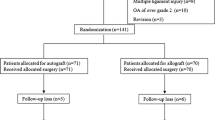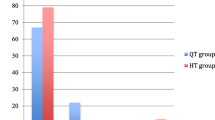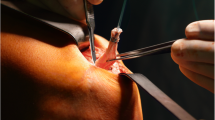Abstract
Purpose
Due to the increased importance of revision ACL reconstruction, this study aims to evaluate the outcome 4 years after the surgery, compare two revision strategies and identify factors that influence the results.
Methods
Seventy-nine patients who received a revision ACL reconstruction were retrospectively evaluated. All patients were assessed with an average follow-up of 4.4 years (range 3.3–5.5 years). The results of patients treated with a quadriceps autograft were compared with those treated with a hamstring autograft.
Results
Ninety-seven percent of patients had a KT-1000 side-to-side difference of ≤ 5 mm (mean 1.7 ± 2.0 mm). Pivot-shift test was absent or minor in 95%. In the SLTH-test, 70% of patients reached 90% of the contralateral side. The mean Lysholm score on follow-up was 83 ± 12 (56% excellent/good). The mean IKDC 2000 subjective evaluation score was 81 ± 14 (58% normal/almost normal). The median Tegner activity score was 6 (range 3–10), a median of 2 levels worse than before the first injury. Return to sport rate was 89% but only 34% of patients reached their pre-injury sport level. Most common cause for this reduction was fear of another injury. Three patients suffered a re-rupture. Patients with a hamstring autograft performed pivoting sports more often, but had worse pivot-shift results compared to those with a quadriceps autograft. No significant influence was seen for other parameters. Young, male patients with a high activity level and no chondral damage had the best results.
Conclusion
Through revision ACL reconstruction, the goal of stabilizing the knee can be achieved in the majority of patients. However, a good function and a high activity level are significantly less common in these patients. The main reason for this is fear of a renewed ACL-injury. Both quadriceps and hamstring autografts were able to achieve a good outcome. Young, male, patients with a normal BMI, a high activity level and without cartilage damage seem to benefit the most from revision ACL surgery. The discrepancy between the good laxity restoration and the lower activity rate should therefore be a main point in clinical counseling when deciding for or against revision ACL-Reconstruction.
Level of evidence
III.


Similar content being viewed by others
References
Ahn JH, Lee YS, Ha HC (2008) Comparison of revision surgery with primary anterior cruciate ligament reconstruction and outcome of revision surgery between different graft materials. Am J Sports Med 36:1889–1895
Andernord D, Desai N, Bjornsson H, Ylander M, Karlsson J, Samuelsson K (2014) Patient predictors of early revision surgery after anterior cruciate ligament reconstruction: a cohort study of 16,930 patients with 2-year follow-up. Am J Sports Med 43(1):121–127
Arastu MH, Grange S, Twyman R (2015) Prevalence and consequences of delayed diagnosis of anterior cruciate ligament ruptures. Knee Surg Sports Traumatol Arthrosc 23:1201–1205
Barie A, Kopf M, Jaber A, Moradi B, Schmitt H, Huber J et al (2018) Long-term follow-up after anterior cruciate ligament reconstruction using a press-fit quadriceps tendon-patellar bone autograft. BMC Musculoskelet Disord 19:368
Barie A, Streich NA, Jürgen H (2013) Arthroscopic anterior cruciate ligament reconstruction using a quadriceps tendon-patellar bone autograft in press-fit fixation. Tech Orthopaed 28:145–148
Battaglia MJ 2nd, Cordasco FA, Hannafin JA, Rodeo SA, O’Brien SJ, Altchek DW et al (2007) Results of revision anterior cruciate ligament surgery. Am J Sports Med 35:2057–2066
Boyer P, Djian P, Christel P, Paoletti X, Degeorges R (2004) [Reliability of the KT-1000 arthrometer (Medmetric) for measuring anterior knee laxity: comparison with Telos in 147 knees]. Rev Chir Orthop Reparatr Appar Mot 90:757–764
Briggs KK, Lysholm J, Tegner Y, Rodkey WG, Kocher MS, Steadman JR (2009) The reliability, validity, and responsiveness of the Lysholm score and Tegner activity scale for anterior cruciate ligament injuries of the knee: 25 years later. Am J Sports Med 37:890–897
Buller LT, Best MJ, Baraga MG, Kaplan LD (2015) Trends in Anterior Cruciate Ligament Reconstruction in the United States. Orthop J Sports Med 3:2325967114563664
Chen JL, Allen CR, Stephens TE, Haas AK, Huston LJ, Wright RW et al (2013) Differences in mechanisms of failure, intraoperative findings, and surgical characteristics between single- and multiple-revision ACL reconstructions: a MARS cohort study. Am J Sports Med 41:1571–1578
Deie M, Sakamaki Y, Sumen Y, Urabe Y, Ikuta Y (2002) Anterior knee laxity in young women varies with their menstrual cycle. Int Orthop 26:154–156
Denti M, Lo Vetere D, Bait C, Schonhuber H, Melegati G, Volpi P (2008) Revision anterior cruciate ligament reconstruction: causes of failure, surgical technique, and clinical results. Am J Sports Med 36:1896–1902
Diamantopoulos AP, Lorbach O, Paessler HH (2008) Anterior cruciate ligament revision reconstruction: results in 107 patients. Am J Sports Med 36:851–860
Erickson BJ, Cvetanovich GL, Frank RM, Riff AJ, Bach BR Jr (2017) Revision ACL reconstruction: a critical analysis review. JBJS Rev 5(6):e1
Galway HR, MacIntosh DL (1980) The lateral pivot shift: a symptom and sign of anterior cruciate ligament insufficiency. Clin Orthop Relat Res 147:45–50
Gans I, Retzky JS, Jones LC, Tanaka MJ (2018) Epidemiology of recurrent anterior cruciate ligament injuries in national collegiate athletic association sports: the injury surveillance program, 2004–2014. Orthop J Sports Med 6:2325967118777823
Gifstad T, Drogset JO, Viset A, Grontvedt T, Hortemo GS (2013) Inferior results after revision ACL reconstructions: a comparison with primary ACL reconstructions. Knee Surg Sports Traumatol Arthrosc 21:2011–2018
Grassi A, Ardern CL, Marcheggiani Muccioli GM, Neri MP, Marcacci M, Zaffagnini S (2016) Does revision ACL reconstruction measure up to primary surgery? A meta-analysis comparing patient-reported and clinician-reported outcomes, and radiographic results. Br J Sports Med 50:716–724
Griffith TB, Allen BJ, Levy BA, Stuart MJ, Dahm DL (2013) Outcomes of repeat revision anterior cruciate ligament reconstruction. Am J Sports Med 41:1296–1301
Grossman MG, ElAttrache NS, Shields CL, Glousman RE (2005) Revision anterior cruciate ligament reconstruction: three- to nine-year follow-up. Arthroscopy 21:418–423
Hamilton RT, Shultz SJ, Schmitz RJ, Perrin DH (2008) Triple-hop distance as a valid predictor of lower limb strength and power. J Athl Train 43:144–151
Han HS, Seong SC, Lee S, Lee MC (2008) Anterior cruciate ligament reconstruction: quadriceps versus patellar autograft. Clin Orthop Relat Res 466:198–204
Hefti F, Muller W, Jakob RP, Staubli HU (1993) Evaluation of knee ligament injuries with the IKDC form. Knee Surg Sports Traumatol Arthrosc 1:226–234
Higgins LD, Taylor MK, Park D, Ghodadra N, Marchant M, Pietrobon R et al (2007) Reliability and validity of the International Knee Documentation Committee (IKDC) Subjective Knee Form. Joint Bone Spine 74:594–599
Hoffman M, Harter RA, Hayes BT, Wojtys EM, Murtaugh P (2008) The interrelationships among sex hormone concentrations, motoneuron excitability, and anterior tibial displacement in women and men. J Athl Train 43:364–372
Johnson WR, Makani A, Wall AJ, Hosseini A, Hampilos P, Li G et al (2015) Patient outcomes and predictors of success after revision anterior cruciate ligament reconstruction. Orthop J Sports Med 3:2325967115611660
Kamath GV, Redfern JC, Greis PE, Burks RT (2011) Revision anterior cruciate ligament reconstruction. Am J Sports Med 39:199–217
Kievit AJ, Jonkers FJ, Barentsz JH, Blankevoort L (2013) A cross-sectional study comparing the rates of osteoarthritis, laxity, and quality of life in primary and revision anterior cruciate ligament reconstructions. Arthroscopy 29:898–905
Konig DP, Rutt J, Kumm D, Breidenbach E (1998) [Diagnosis of anterior knee instability. Comparison between the Lachman test, the KT-1,000 arthrometer and the ultrasound Lachman test]. Unfallchirurg 101:209–213
Kvist J, Kartus J, Karlsson J, Forssblad M (2014) Results from the swedish national anterior cruciate ligament register. Arthroscopy. https://doi.org/10.1016/j.arthro.2014.02.036
Lind M, Menhert F, Pedersen AB (2012) Incidence and outcome after revision anterior cruciate ligament reconstruction: results from the Danish registry for knee ligament reconstructions. Am J Sports Med 40:1551–1557
MARSGroup (2014) Effect of graft choice on the outcome of revision anterior cruciate ligament reconstruction in the Multicenter ACL Revision Study (MARS) Cohort. Am J Sports Med 42:2301–2310
Noyes FR, Barber-Westin SD (2001) Revision anterior cruciate ligament reconstruction: report of 11-year experience and results in 114 consecutive patients. Instr Course Lect 50:451–461
Pascual-Garrido C, Carbo L, Makino A (2014) Revision of anterior cruciate ligament reconstruction with allografts in patients younger than 40 years old: a 2 to 4 year results. Knee Surg Sports Traumatol Arthrosc 22:1106–1111
Rangger C, Daniel DM, Stone ML, Kaufman K (1993) Diagnosis of an ACL disruption with KT-1000 arthrometer measurements. Knee Surg Sports Traumatol Arthrosc 1:60–66
Roos EM, Lohmander LS (2003) The Knee injury and Osteoarthritis Outcome Score (KOOS): from joint injury to osteoarthritis. Health Qual Life Outcomes 1:64
Ryan J, Magnussen RA, Cox CL, Hurbanek JG, Flanigan DC, Kaeding CC (2014) ACL reconstruction: do outcomes differ by sex? A systematic review. J Bone Joint Surg Am 96:507–512
Salmon LJ, Pinczewski LA, Russell VJ, Refshauge K (2006) Revision anterior cruciate ligament reconstruction with hamstring tendon autograft: 5- to 9-year follow-up. Am J Sports Med 34:1604–1614
Samitier G, Marcano AI, Alentorn-Geli E, Cugat R, Farmer KW, Moser MW (2015) Failure of anterior cruciate ligament reconstruction. Arch Bone Jt Surg 3:220–240
Sanders TL, Maradit Kremers H, Bryan AJ, Larson DR, Dahm DL, Levy BA et al (2016) Incidence of anterior cruciate ligament tears and reconstruction: a 21-year population-based study. Am J Sports Med 44:1502–1507
Taylor SA, Khair MM, Roberts TR, DiFelice GS (2015) Primary repair of the anterior cruciate ligament: a systematic review. Arthroscopy 31:2233–2247
Tegner Y, Lysholm J (1985) Rating systems in the evaluation of knee ligament injuries. Clin Orthop Relat Res 43–49
Torg JS, Conrad W, Kalen V (1976) Clinical diagnosis of anterior cruciate ligament instability in the athlete. Am J Sports Med 4:84–93
Trojani C, Sbihi A, Djian P, Potel JF, Hulet C, Jouve F et al (2011) Causes for failure of ACL reconstruction and influence of meniscectomies after revision. Knee Surg Sports Traumatol Arthrosc 19:196–201
Weiler A, Schmeling A, Stohr I, Kaab MJ, Wagner M (2007) Primary versus single-stage revision anterior cruciate ligament reconstruction using autologous hamstring tendon grafts: a prospective matched-group analysis. Am J Sports Med 35:1643–1652
Wright RW, Gill CS, Chen L, Brophy RH, Matava MJ, Smith MV et al (2012) Outcome of revision anterior cruciate ligament reconstruction: a systematic review. J Bone Joint Surg Am 94:531–536
Wright RW, Huston LJ, Spindler KP, Dunn WR, Haas AK, Allen CR et al (2010) Descriptive epidemiology of the Multicenter ACL Revision Study (MARS) cohort. Am J Sports Med 38:1979–1986
Zantop T, Petersen W (2011) [Arthroscopic filling of misplaced and wide bone tunnels after reconstruction of the anterior cruciate ligament with bone graft in patients with recurrent instability.]. Oper Orthop Traumatol 23(4):337–350
Funding
This clinical study was internally funded. No external or 3rd party financial support was needed.
Author information
Authors and Affiliations
Contributions
AB and NS were responsible for the idea and conception of the study. All authors planned the study protocol. AB, NS and JH performed all operations and re-operations mentioned in the study. YE was responsible for the organization of all clinical trials as well as data acquisition. AB, NS and YE performed the clinical examination for all study participants. AB, YE and AJ did the statistical analysis and interpreted the results. AB, YE and AJ wrote the Manuscript. All authors read and approved the final manuscript.
Corresponding author
Ethics declarations
Conflict of interest
The authors declare that they have no competing interests.
Ethics committee approval and consent to participate
This study has been approved by the appropriate ethics committee in Heidelberg University in Germany (registration number: S-482/14) and has therefore been performed in accordance with the ethical standards laid down in the 1964 Declaration of Helsinki. All persons gave their informed consent prior to their inclusion in the study.
Additional information
Publisher’s Note
Springer Nature remains neutral with regard to jurisdictional claims in published maps and institutional affiliations.
Rights and permissions
About this article
Cite this article
Barié, A., Ehmann, Y., Jaber, A. et al. Revision ACL reconstruction using quadriceps or hamstring autografts leads to similar results after 4 years: good objective stability but low rate of return to pre-injury sport level. Knee Surg Sports Traumatol Arthrosc 27, 3527–3535 (2019). https://doi.org/10.1007/s00167-019-05444-z
Received:
Accepted:
Published:
Issue Date:
DOI: https://doi.org/10.1007/s00167-019-05444-z




